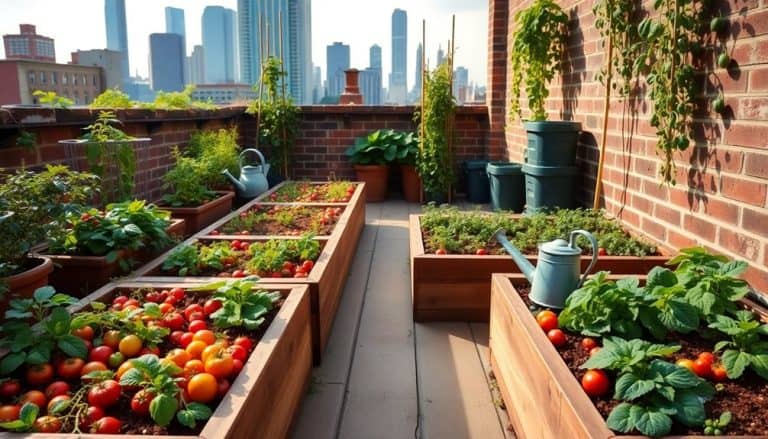This website contains affiliate links. Some products are gifted by the brand to test. As an Amazon Associate, I earn from qualifying purchases. The content on this website was created with the help of AI.
You can create beautiful garden trellises from reclaimed wood using simple designs and basic tools. Start by sourcing wood from construction sites, old fences, or pallets, then remove nails and clean the pieces thoroughly. A basic lean-to design works well for beginners – just lean vertical supports against a wall at an angle and add horizontal crossbars. For a sturdier option, try a ladder-style trellis with posts buried in concrete. Repurposed window frames make charming trellises when fitted with wire mesh for climbing plants. These DIY projects transform discarded materials into functional garden features, and there’s so much more you can do with salvaged wood.
Key Takeaways
- Transform old window frames into charming trellises by removing glass and attaching wire mesh for climbing plants to grow.
- Create a simple lean-to trellis using reclaimed lumber, positioned at 65-75 degrees against walls with crossbars every 12 inches.
- Build ladder-style supports from salvaged deck boards, spacing rungs 8-12 inches apart for optimal vine climbing.
- Repurpose wooden pallets into vertical garden trellises by adding planter boxes for herbs and hanging potted plants.
- Construct diamond-patterned trellises from old fence boards, ensuring proper weather protection with exterior sealant for longevity.
Finding and Preparing Reclaimed Wood
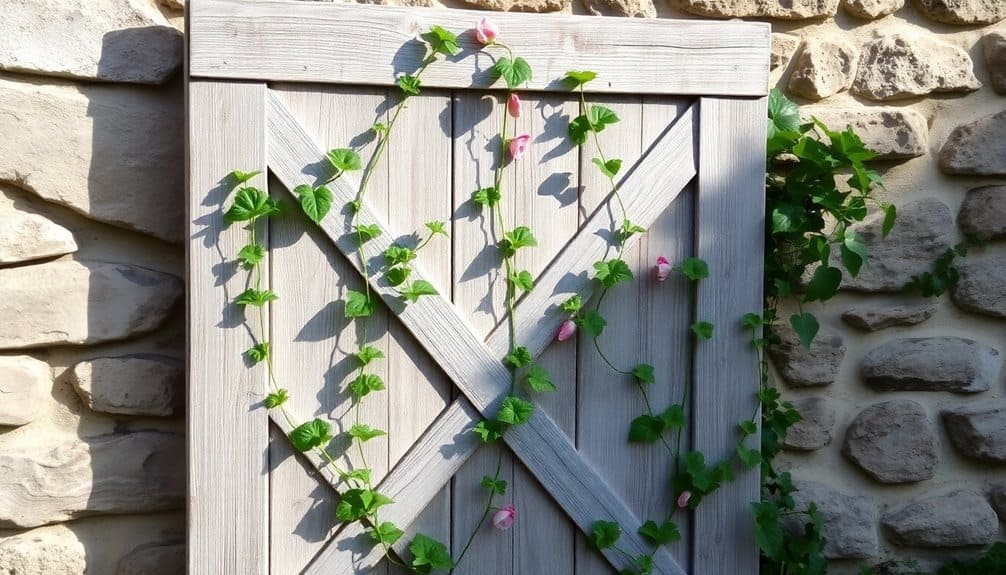
Several excellent sources exist for finding reclaimed wood to build your garden trellis. Check local construction sites, where you’ll often find discarded lumber from renovations. Visit architectural salvage yards and ReStore locations, which specialize in used building materials. Don’t overlook old fences, barns, or pallets – they’re goldmines for weathered wood with character. You can also connect with local woodworkers who might have scraps they’re willing to share. Once you’ve collected your materials, consider installing a wall-mounted rack to keep your garden tools organized while you work.
Before using reclaimed wood, you’ll need to prepare it properly. Start by removing all nails, screws, and metal fragments using a pry bar and hammer. Sand rough edges to prevent splinters, but don’t eliminate all the natural weathering that gives the wood its charm. Check for signs of rot, and discard any pieces that are structurally compromised. If you spot insect damage, treat the wood with a natural borate solution to prevent further infestation. Finally, clean the wood thoroughly with a wire brush to remove dirt and debris. While you don’t need to seal the wood, a coat of exterior-grade sealer will extend its life outdoors.
Basic Lean-To Trellis Design

Once your reclaimed wood is ready, a lean-to trellis offers the simplest starting point for your garden project. This design consists of vertical supports leaning against a wall or fence at a 65-75 degree angle, with horizontal cross pieces attached for climbing plants. You’ll need two long pieces for the main supports and several shorter pieces for the crossbars.
Start by measuring and cutting your vertical supports to equal lengths, typically 6-8 feet long. Position them about 3 feet apart and mark where they’ll meet the wall. Attach rubber or felt pads at these contact points to prevent wood damage. Secure the bottom ends into the soil about 12 inches deep, or anchor them in concrete for greater stability.
Add your horizontal crossbars at 12-inch intervals, starting from the bottom. Pre-drill holes to prevent splitting, then attach the crossbars using weatherproof screws or nails. Make sure each crossbar is level before securing it. You can reinforce the structure by adding diagonal braces between the verticals if needed. Don’t forget to treat any exposed cut ends with wood preservative to extend your trellis’s lifespan. For areas with frequent strong winds, consider installing diagonal braces to strengthen the structure and improve stability.
Ladder Style Garden Support
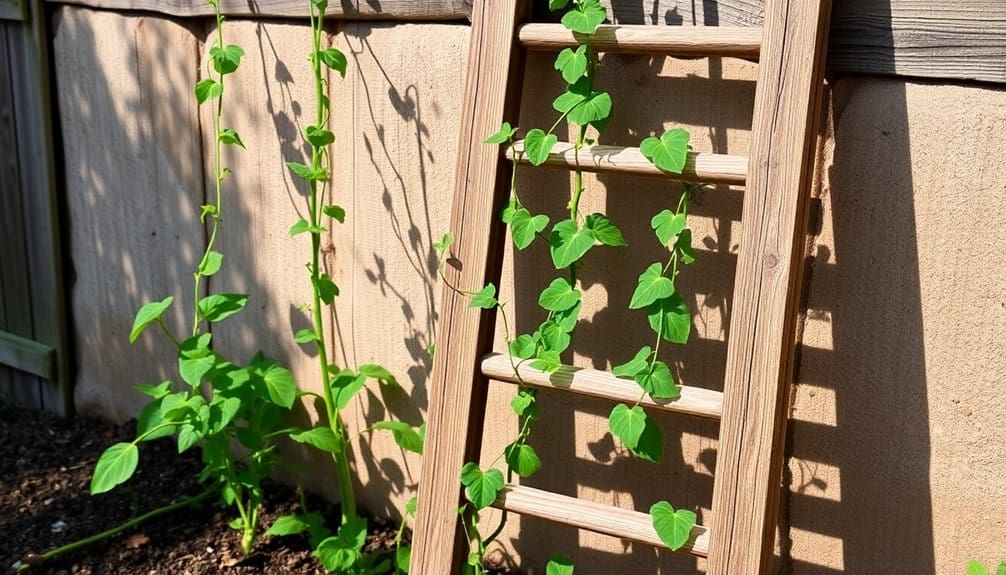
The ladder-style garden support regularly ranks among the most versatile trellis designs you can build from reclaimed wood. It’s perfect for climbing vegetables like peas and beans, while also providing sturdy support for flowering vines and compact squash varieties. You’ll need two long vertical posts and several shorter horizontal rungs to create this practical structure.
When selecting your reclaimed wood, look for boards that are at least 1×4 inches in thickness for the vertical supports. Old deck boards or fence posts work exceptionally well. Space your horizontal rungs 8-12 inches apart to give plants plenty of room to climb and spread. You can secure the rungs using exterior wood screws or, for a more authentic look, traditional mortise and tenon joints.
To increase stability, bury the vertical posts at least 18 inches deep and anchor them with concrete if you’re placing the trellis in an exposed area. Consider adding a slight backward tilt to your ladder design – about 15 degrees – which will help climbing plants grow more naturally and make harvesting easier. You’ll want to treat any raw wood with a plant-safe sealant to extend its lifespan. Similar to beehive stands, your trellis should undergo annual inspections to check for loose parts or visible damage that may compromise its structural integrity.
Diamond Pattern Lattice Structure
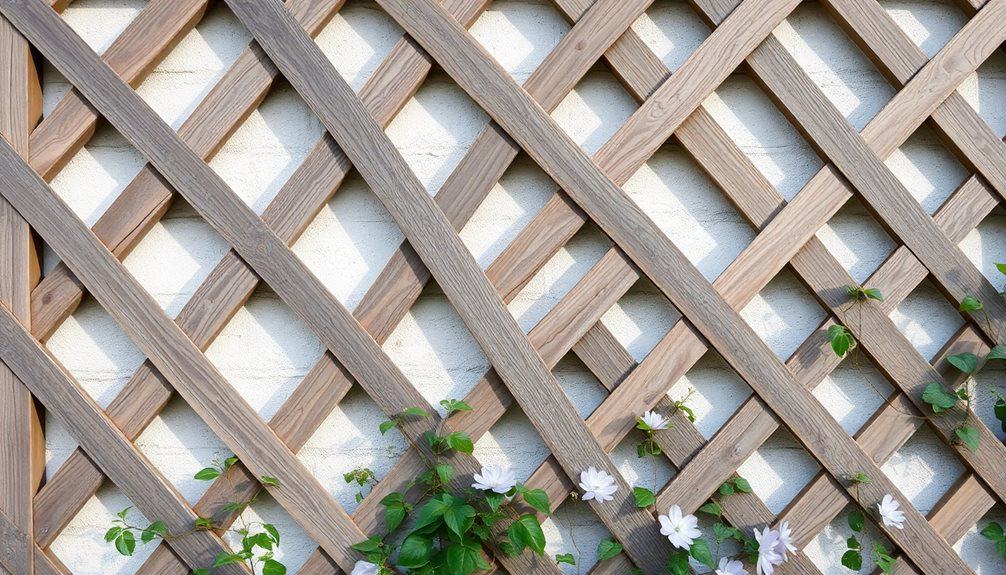
Creating a diamond pattern lattice from reclaimed wood adds both visual interest and practical functionality to your garden space. This classic design works particularly well for climbing plants like clematis, jasmine, and morning glories. You’ll need several lengths of reclaimed wood strips, measuring approximately 1-inch wide and ¼-inch thick, along with weatherproof screws and a mounting frame.
- Start by building a sturdy rectangular frame from thicker pieces of reclaimed wood, ensuring the corners are square and secure
- Position your wood strips diagonally across the frame at 45-degree angles, spacing them 6-8 inches apart
- Layer additional strips in the opposite direction to create the signature diamond pattern, securing each intersection with small screws or weatherproof nails
- Sand any rough edges and apply an outdoor sealant to protect your lattice from the elements
When mounting your completed lattice, position it slightly away from walls or fences to allow for proper air circulation and vine growth. You can customize the diamond sizes by adjusting the spacing between strips, creating either a tight or loose pattern depending on your climbing plants’ needs. For optimal plant health, ensure your trellis has UV protection features similar to those found in greenhouse panels to shield delicate climbing vines.
Repurposed Window Frame Trellis
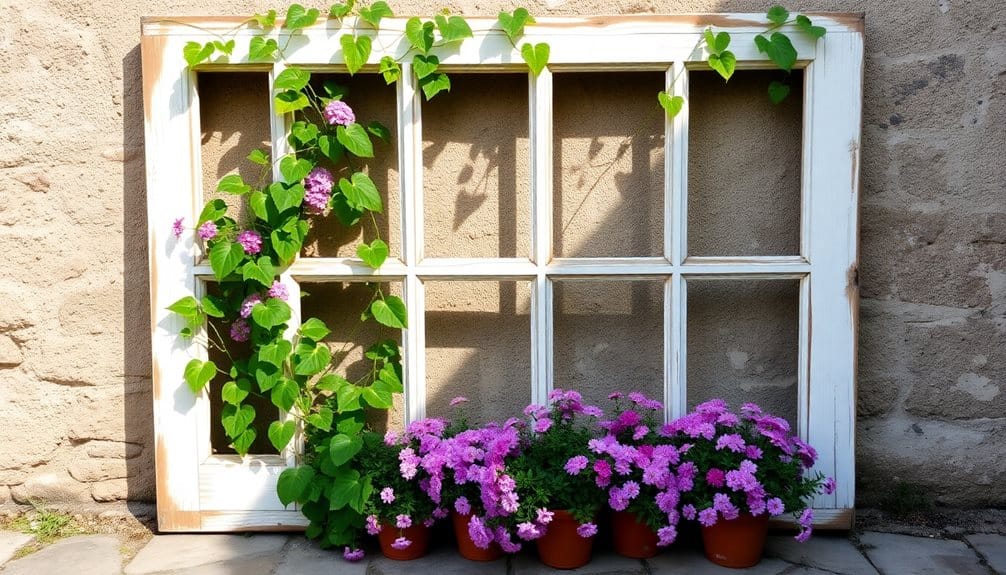
Repurposed vintage window frames make stunning garden trellises while adding architectural character to your outdoor space. You’ll find these frames at salvage yards, flea markets, or during home renovations. Look for frames that still have their original hardware and a sturdy construction, even if the glass is missing or broken.
To transform a window frame into a trellis, remove any remaining glass and sand rough edges smooth. You can leave the original paint for a weathered look or apply exterior paint in your chosen color. Attach strong wire mesh or chicken wire to the back of the frame using rust-resistant staples. This creates a grid for climbing plants to grip.
Mount your window frame trellis securely to fence posts, exterior walls, or insert it into the ground using 4×4 posts. You’ll want to dig at least 2 feet deep for stability. Consider placing multiple frames side by side for a larger growing area. Plant climbing roses, clematis, or morning glories at the base – they’ll weave through the wire backing and create a living picture frame effect in your garden. For optimal longevity, apply a UV-resistant clear coat to protect the frame from weather damage and color fading.
Pallet Wood Garden Screen

From humble shipping pallets, you can construct an eye-catching garden screen that doubles as a vertical planting surface. When dismantled carefully, pallets provide sturdy slats and support pieces perfect for creating a rustic trellis screen. You’ll need to remove the nails, sand rough edges, and treat the wood to withstand outdoor conditions. Consider applying a natural sealer or eco-friendly wood preservative to extend your screen’s lifespan.
- Build a solid frame using the thicker pallet supports, anchoring them securely in the ground with concrete or metal post anchors
- Space horizontal slats evenly, leaving 6-8 inch gaps for climbing plants to weave through
- Add diagonal bracing for stability and visual interest, creating diamond or triangular patterns
- Mount small planter boxes made from pallet wood directly onto the screen for housing herbs or compact flowering plants
Position your pallet screen strategically to provide privacy, define garden spaces, or mask unsightly views. Attach S-hooks or eye screws to hang small potted plants, creating a living wall effect. For added stability in windy areas, consider installing the screen in a zigzag pattern rather than a straight line.
Essential Tools and Hardware
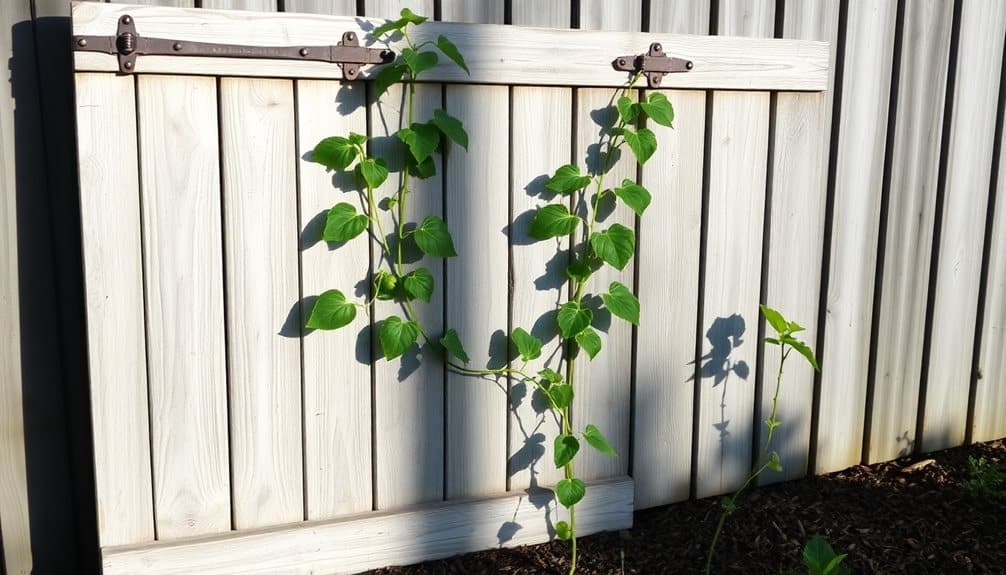
To build a reclaimed wood trellis successfully, you’ll need a core set of tools and basic hardware supplies. Essential tools include a hammer, drill with various drill bits, measuring tape, pencil, level, saw (hand saw or power saw), safety glasses, and work gloves. Don’t forget a sturdy pair of pliers and a pry bar for removing old nails from reclaimed wood.
Your hardware list should include galvanized screws in various lengths (2-inch and 3-inch are most common), exterior-grade wood screws, and rust-resistant nails. You’ll also need metal brackets or corner braces for joining wood pieces securely. Consider picking up some concrete anchors if you’re mounting the trellis to masonry walls.
For finishing touches, grab some 80-grit and 120-grit sandpaper to smooth rough edges. If you’re planning to protect the wood, add exterior wood sealer or weather-resistant paint to your supply list. Keep wood glue on hand for reinforcing joints, and grab some wire staples if you’ll be adding mesh or wire panels for climbing plants. Remember to choose weather-resistant hardware that won’t rust or deteriorate outdoors.
Frequently Asked Questions
How Long Will a Reclaimed Wood Trellis Last Outdoors Without Protective Treatment?
Without protective treatment, your reclaimed wood trellis will typically last 2-3 years outdoors, depending on your climate and the wood type. You’ll notice faster deterioration in wet conditions or if the wood contacts soil directly. Cedar and redwood naturally resist decay and might last 4-5 years, while pine or fir will break down quicker. To extend its life, you’ll want to seal it properly.
Can Climbing Vegetables Damage or Weaken Wooden Trellises Over Time?
Like gentle giants reaching for the sky, climbing vegetables can indeed affect your wooden trellis over time. You’ll notice their tendrils and vines create constant pressure as they twist and grow, while moisture gets trapped between the plant and wood surface. Heavy producers like squash and melons pose the biggest risk, so you’ll want to reinforce your trellis with extra supports and regularly check for signs of weakness.
What Is the Maximum Height Recommended for Freestanding Garden Trellises?
For freestanding garden trellises, you’ll want to keep the height between 6 to 8 feet maximum for ideal stability. If you’re building taller than that, you’ll need to secure your trellis with sturdy posts buried at least 2 feet deep in concrete. Remember that wind load increases considerably with height, so any trellis over 8 feet should be anchored to a building or fence for safety and durability.
Should Trellises Be Removed or Covered During Winter Months?
An ounce of prevention is worth a pound of cure when it comes to winter trellis care. You don’t need to remove your trellises during winter, but you’ll want to protect wooden ones from moisture damage. If you’re growing perennial vines, keep the trellis in place to support the plant’s structure. For metal or plastic trellises, you can leave them as is, but wooden ones benefit from a weatherproof cover or sealant.
How Far From House Walls Should Wooden Trellises Be Installed?
You’ll want to install wooden trellises at least 6-12 inches away from your house walls to prevent moisture buildup and wood rot. This gap allows proper airflow, lets vines grow without damaging your siding, and makes maintenance easier. If you’re growing aggressive climbing plants, consider placing the trellis even further – up to 18 inches from the wall – to protect your home’s exterior and foundation.



